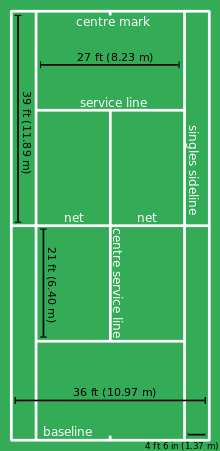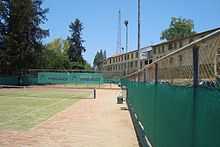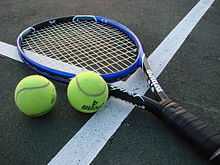Tennis court

A tennis court is the venue where the sport of tennis is played. It is a firm rectangular surface with a low net stretched across the center. The same surface can be used to play both doubles and singles matches. A variety of surfaces can be used to create a tennis court, each with its own characteristics which affect the playing style of the game.
Dimensions

Tennis is played on a rectangular flat surface, usually of grass, clay, concrete (hard court) or a synthetic suspended court. The dimensions of a tennis court are defined and regulated by the International Tennis Federation (ITF) governing body and are written down in the annual 'Rules of Tennis' document.[1] The court is 23.78 meters (78.0 feet) long, 10.97 meters (36.0 feet) wide. Its width is 8.23 meters (27.0 feet) for singles matches and 10.97 meters (36.0 feet) for doubles matches.[2] The service line is 6.40 meters (21.0 feet) from the net.[2] Additional clear space around the court is needed in order for players to reach overrun balls for a total of 18.3 meters (60 feet) wide and 36.7 meters (120 feet) long. A net is stretched across the full width of the court, parallel with the baselines, dividing it into two equal ends. The net is 1.07 meters (3 feet 6 inches) high at the posts, and 0.914 meters (3.00 feet) high in the center.[3] The net posts are 3 feet (0.91 m) outside the doubles court on each side or, for a singles net, 3 feet (0.91 m) outside the singles court on each side.
Orientation
A north–south orientation is generally desirable for outdoor courts to avoid background glare at dawn or dusk. Orientation may also take into consideration other structures and features on the site, neighboring property, vehicle and pedestrian traffic, and prevailing winds. Topography of the site and efficient site utilization are other important considerations.
Types of tennis courts
Tennis is played on a variety of surfaces and each surface has its own characteristics which affect the playing style of the game. There are four main types of courts depending on the materials used for the court surface: clay courts, hard courts, grass courts and carpet courts. The International Tennis Federation (ITF) lists different surfaces and properties and classifies surfaces into one of five pace settings:[4]
- Category 1 (slow)
- Category 2 (medium-slow)
- Category 3 (medium)
- Category 4 (medium-fast)
- Category 5 (fast)
Of the Grand Slam tournaments, the US Open and Australian Open use hard courts (though both used grass courts in the past, and the US Open used clay courts from 1975 through 1977), the French Open is played on clay (though it too was played on grass before 1928), and Wimbledon has always been played on grass.
ITF uses the following classification for tennis court surface types:[5]
| Surface code | Type | Description |
| A | Acrylic | Textured, pigmented, resin-bound coating |
| B | Artificial clay | Synthetic surface with the appearance of clay |
| C | Artificial grass | Synthetic surface with the appearance of natural grass |
| D | Asphalt | Bitumen-bound aggregate |
| E | Carpet | Textile or polymeric material supplied in rolls or sheets of finished product |
| F | Clay | Unbound mineral aggregate |
| G | Concrete | Cement-bound aggregate |
| H | Grass | Natural grass grown from seed |
| J | Other | E.g. modular systems (tiles), wood, canvas |
Clay courts

Clay courts are made of crushed shale, stone, or brick. The French Open is the only Grand Slam tournament to use clay courts.
Clay courts slow down the ball and produce a high bounce in comparison to grass courts or hard courts. For this reason, the clay court takes away lot of advantage of big serves, which makes it hard for serve-based players to dominate on the surface. Clay courts are cheaper to construct than other types of tennis courts, but a clay surface costs more to maintain. Clay courts need to be rolled to preserve flatness. The clay's water content must be balanced; green courts generally require the courts to be sloped to allow water run-off.
Clay courts are more common in Europe and Latin America than in North America and tend to heavily favour baseline players.
According to the world tour calendar published on the ATP World Tour website, the following important tournaments are organized on clay:[6]
Grand Slam tournament: Roland Garros
ATP World Tour Masters 1000: Monte Carlo, Madrid, Rome
Grass courts

Grass courts are the fastest type of courts in common use (AstroTurf is faster but is primarily used only for personal courts). They consist of grass grown on very hard-packed soil, which adds additional variables: bounces depend on how healthy the grass is, how recently it has been mown, and the wear and tear of recent play. Points are usually very quick where fast, low bounces keep rallies short, and the serve plays a more important role than on other surfaces. Grass courts tend to favour serve-and-volley tennis players, such as John McEnroe and Pete Sampras among men and Martina Navratilova and Jana Novotná among women. The surface is less firm and more slippery than hard courts, causing the ball to slide and bounce lower, and so players must reach the ball faster. Serve-and-volley players take advantage of the surface by serving the ball (usually a slice serve because of its effectiveness on grass) and then running to the net to cut off the return of serve, leaving their opponent with little time to reach the low-bouncing, fast-moving ball. Players often hit flatter shots to increase power and allow the ball to travel faster before and after the ball hits the ground.
In 2001, Wimbledon organizers changed the grass to 100% perennial rye in addition to changing to a harder and denser soil, with both providing for a higher bounce to the ball and slower play.[7] Grass court specialist Tim Henman spoke out against this change in 2002, stating "What on earth is going on here? I'm on a grass court and it's the slowest court I've played on this year".[8] As a result, serving and volleying has become rare at Wimbledon and dominant baseliners such as Rafael Nadal, Venus Williams, and Serena Williams have won many titles. Tennis at the 2012 Olympics was played on grass courts.
Grass courts were once among the most common tennis surfaces, but are now rare due to high maintenance costs, as they must be watered and mown often, and take a longer time to dry after rain than hard courts. The grass surface, however, is the most compatible with the human body because of its softness. For a more extensive discussion of the skills most advantageous on grass court, see grass-court specialist.
According to the official world tour calendar published on the ATP and WTA websites, the following tournaments are organized on grass:
ATP World Tour 250: Rosmalen Grass Court Championships, Hall of Fame Tennis Championships,
ATP World Tour 500: Halle Open, Queen's Club Championships,
ATP World Tour Masters 1000: None
WTA Premier: Eastbourne International, Birmingham Classic
Grand Slam tournament: Wimbledon
Hard courts

Hard courts are made of uniform rigid material, offering greater consistency of bounce than other outdoor surfaces.[9] Hard courts can vary in speed, although they are faster than clay but not as fast as grass courts. The quantity of sand added to the paint can greatly affect the rate at which the ball slows down.[10] Hard courts are generally more equalizing than clay or grass in terms of playing style, although they favor harder-hitting baseliners and all-court styles with the current equipment. The US Open is played on DecoTurf, while the Australian Open is played on Plexicushion, both acrylic based hard court surfaces (with more attenuation of the ball trajectory on the latter surface type). The main difference between these two surface types is the level of hardness, given by the amount of cushioning in the under-layers. The amount of sand used in the top paint and the size of the sand granules also determines the speed – more sand means less speed and larger sand particles will slow the speed of play, due to friction; this will produce a clay court effect, where topspin is magnified. The extra grip and friction will resist the sliding effect of the ball and the resistance will force the ball to change its rotation.
Aside from the US Open and the Australian Open, the following important tournaments are organized on hard courts:
ATP World Tour Finals: London
ATP World Tour Masters 1000: Indian Wells, Miami, Toronto/Montreal, Cincinnati, Shanghai, Paris
Carpet courts
Carpet is a tennis term for any removable court covering. A short form of artificial turf weighted with sand is common in Asia. Indoor arenas store rolls of rubber-backed court surfacing and install it temporarily for tennis events, however they are not in use any more for professional events. Carpet is generally a fast surface (more than hardcourt), with low bounce.
Notable tennis tournaments held on carpet courts were the WCT Finals, Paris Masters, U.S. Pro Indoor and Kremlin Cup. Since 2009 their use has been discontinued on the ATP tour.
Indoor courts
Hard courts[9] are most common indoors, as they are made with the most versatile materials and surface finishes. Medium fast bouncing surfaces, made of a mixture of rubber granules and synthetic resin, are used for a cushioned feel (i.e. the GreenSet surfaces). Carpet surfaces have been used both on the ATP World Tour and the World Championship Tennis circuit. Clay courts are installed indoors with underground watering systems, and used mostly for Davis Cup matches. The conclusion of the Wimbledon Championships, in 2012, was played on the lawn of the Centre Court under the roof and artificial lights. Efficient chromatic and lighting conditions of play are currently employed for the ATP World Tour Finals – an obvious evolution since the days of the World Covered Court Championships, played on wood floors. Barnstorming professionals played on canvas laid over wooden basketball courts up to the 1960s. In unofficial settings, tennis is played on a variety of surfaces indoors: hardwood, granite slabs, acrylic, plastic tiles, artificial grass carpets, etc. For information about the original indoor tennis and tennis courts see real tennis and history of tennis.
According to the official world tour calendar published on the ATP World Tour website, the following tournaments are organized indoors:
ATP World Tour 250: Montpellier, Zagreb, Memphis, Marseille, São Paulo, Metz, Kuala Lumpur, Moscow, Stockholm, Vienna
ATP World Tour 500: Rotterdam, Valencia, Basel
ATP World Tour Masters 1000: Paris
ATP World Tour Finals: London
Except for the tournament in São Paulo, which is played on clay, the other tournaments listed here are played on hard courts (most of them, specifically on GreenSet).
Smaller courts
The ITF campaign Play and Stay aims to increase tennis participation worldwide, by improving the way children are introduced to the game. The campaign promotes playing on smaller courts with slower red, orange and green balls. This gives children more time and control so that they can serve, rally, and score from the first lesson on courts that are sized to fit their bodies. The ITF has mandated that official competition for children under 10 years of age should be played on so-called Orange courts 18 m (59 ft) long by 6.4 m (21 ft) wide. Competition for children under 8 years is played on Red courts that are 11 m (36 ft) long and 5.5 m (18 ft) wide. The net is 0.8m high in the center.[11]
Terminology
Common tennis court terms:
- Advantage service box or ad court: The receiver's left side service box, or the opponent's right for the server; significant as the receiving side for an ad point.
- Alley (Tramlines): The lanes on each side of the singles court, one on the ad side, one on the deuce side. These are only used when playing doubles.
- Back court ('No man's land'): The area between the baseline and the service line. It is not recommended to play in this area because this is where balls usually bounce.
- Baseline: The rearmost line of the court, furthest from and parallel to the net.
- Center service line: The line dividing the two service boxes on each side.
- Center niblet: The 12-inch mark at the halfway point of the baseline used to distinguish the two halves (and service boxes) of a tennis court.
- Deuce service box or deuce court: The receiver's right side service box, or the opponent's left for the server, significant as the receiving side for a deuce point.
- Middle T: See T.
- Service box: The area on each side bounded by the singles sideline, the service line, and the net. There are left and right service boxes, separated by the center service line.
- Service line: The line that is parallel to the net and is located between the baseline and the net. It marks the end of the service boxes.
- Side T: The T shape formed by the service line and the singles sideline. There are four such side Ts, two on each side of the net.
- T or Middle T: The T shape formed by the service line and the center service line.
References
- ↑ "ITF – Rulebooks – Rules of Tennis". ITF.
- ↑ 2.0 2.1 "Rule 1 – The Court". International Tennis Federation. Retrieved 13 September 2009.
- ↑ Rules of tennis
- ↑ "Court Pace Classification Programme". ITF. Retrieved 1 October 2012.
- ↑ "ITF Approved Tennis Balls, Classified Surfaces & Recognised Courts 2012" (PDF). ITF. p. 62.
- ↑ "ATP tournaments". Association of Tennis Professionals (ATP).
- ↑ "The Grass is Always Slower". BBC News. 23 June 2005. Retrieved 6 January 2010.
- ↑ "At Wimbledon, It's the Grass Stupid". Time. 18 June 2008. Retrieved 25 May 2010.
- ↑ 9.0 9.1 "Hard Courts Make Tennis Champions". The New York Times. 3 November 1912.
- ↑ Tennis Universal
- ↑ ITF Play and Stay
External links
| ||||||||||||||||||||||||||||||||||||||||||||

